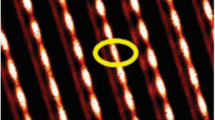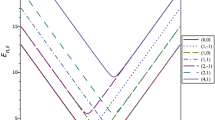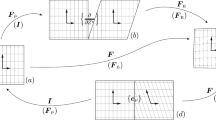Abstract
This brief review recalls some chapters in theory of sliding incommensurate density waves which may have appeared after inspirations from studies of Dzyaloshinskii and collaborations with him. First we address the spin density waves which rich order parameter allows for an unusual object of a complex topological nature: a half-integer dislocation combined with a semi-vortex of the staggered magnetization. It becomes energetically preferable with respect to an ordinary dislocation due to the high Coulomb energy at low concentration of carriers. Generation of these objects should form a sequence of π-phase slips in accordance with experimental doubling of the phase-slips rate. Next, we revise the commonly employed TDGL approach which is shown to suffer from a violation of the charge conservation law resulting in nonphysical generation of particles which is particularly pronounced for electronic vortices in the course of their nucleation or motion. The suggested consistent theory exploits the chiral transformations taking into account the principle contribution of the fermionic chiral anomaly to the effective action. The derived equations clarify partitions of charges, currents, and rigidity among subsystems of condensed and normal carriers and the gluing electric field. Being non-analytical with respect to the order parameter, contrarily the conventional TDGL type, the resulting equations still allow for a numerical modeling of transient processes related to space- and spatiotemporal vorticity in DWs.




Similar content being viewed by others
REFERENCES
S. A. Brazovskii, I. E. Dzyaloshinskii, and N. N. Kirova, Sov. Phys. JETP 54, 1209 (1981).
S. A. Brazovskii and I. E. Dzyaloshinskii, Sov. Phys. JETP 44, 1233 (1976).
S. A. Brazovskii, I. E. Dzyaloshinskii, and S. P. Obukhov, Sov. Phys. JETP 45, 814 (1977).
S. Brazovskii and N. Kirova, Sov. Sci. Rev. A 5, 99 (1984).
S. Brazovskii, in Advances in Theoretical Physics: Landau Memorial Conference, AIP Conf. Proc. 1134, 74 (2009).
I. Dzyaloshinskii, Nobel Symp. 24, 143 (1973).
S. A. Brazovskii, I. E. Dzyaloshinskii, and I. M. Krichever, Sov. Phys. JETP 56, 212 (1982).
S. A. Brazovskii, I. E. Dzyaloshinskii, and I. M. Krichever, Phys. Lett. A 91, 40 (1982).
I. E. Dzyaloshinskii and I. M. Krichever, Sov. Phys. JETP 56, 908 (1982).
I. E. Dzyaloshinskii and I. M. Krichever, Sov. Phys. JETP 58, 1031 (1983).
N. Kirova and S. Brazovskii, J. Phys. IV 9, Pr10-119 (1999).
N. Kirova and S. Brazovskii, J. Phys. IV 10, Pr3-183 (2000).
I. E. Dzyaloshinskii, JETP Lett. 25, 98 (1977).
S. Brazovskii and N. Kirova, J. Phys. IV 9, Pr10-139 (1999).
S. Brazovskii and N. Kirova, Ann. Phys. 403, 184 (2019).
S. Brazovskii and N. Kirova, J. Exp. Theor. Phys. 129, 659 (2019).
G. E. Volovik and V. P. Mineev, JETP Lett. 24, 561 (1976).
M. C. Cross and W. F. Brinkman, J. Low Temp. Phys. 27, 683 (1977).
I. A. Lukyanchuk and M. E. Zhitomirsky, Supercond. Rev. 1, 207 (1995).
G. Volovik, Proc. Natl. Acad. Sci. U. S. A. 97, 2431 (2000).
L. Radzihovsky and A. Vishwanath, Phys. Rev. Lett. 103, 010404 (2009).
S. Brazovskii, Phys. B (Amsterdam, Neth.) 404, 482 (2009).
Y. G. Rubo, Phys. Rev. Lett. 99, 106401 (2007).
V. P. Mineev, Low Temp. Phys. 39, 1056 (2013).
S. I. Anisimov and I. E. Dzyaloshinskii, Sov. Phys. JETP 31, 773 (1970).
I. E. Dzyaloshinskii and G. E. Volovik, Ann. Phys. 125, 67 (1980).
P. Monceau, Adv. Phys. 61, 325 (2012).
G. Grüner, Rev. Mod. Phys. 60, 1129 (1988).
G. Grüner, Rev. Mod. Phys. 66, 1 (1994).
Charge Density Waves in Solids, Ed. by L. Gor’kov and G. Grüner (Elsevier Science, Amsterdam, 1990).
P. Karpov and S. Brazovskii, Phys. Rev. E 99, 022114 (2019).
S. Brazovskii, J. Supercond. Nov. Magn. 20, 489 (2007).
D. Feinberg and J. Friedel, J. Phys. 49, 485 (1988).
S. Brazovskii and S. Matveenko, Sov. Phys. JETP 72, 864 (1992).
M. Hayashi and H. Yoshioka, Phys. Rev. Lett. 77, 3403 (1996).
S. Brazovskii, in Charge Density Waves in Solids, Ed. by L. Gor’kov and G. Grüner (Elsevier, Amsterdam, 1990), p. 425.
N. P. Ong, G. Varma, and K. Maki, Phys. Rev. Lett. 52, 663 (1984).
N. P. Ong and K. Maki, Phys. Rev. B 32, 6582 (1985).
L. P. Gorkov, JETP Lett. 38, 87 (1983).
L. P. Gor’kov in Charge Density Waves in Solids, Ed. by L. Gor’kov and G. Grüner (Elsevier, Amsterdam, 1990), p. 403.
L. P. Gor’kov, Sov. Phys. JETP 59, 1057 (1984).
I. Batistic, A. Bjelis, and L. Gor’kov, J. Phys. 45, 1049 (1984).
A. I. Larkin and S. Brazovskii, Solid State Commun. 93, 275 (1995).
S. Brazovskii and T. Nattermann, Adv. Phys. 53, 177 (2004).
T. Yi, N. Kirova and S. Brazovskii, Eur. Phys. J. ST 222, 1035 (2013).
T. Yi, A. Rojo Bravo, N. Kirova, and S. Brazovskii, J. Supercond. Nov. Mag. 28, 1343 (2015).
S. N. Artemenko, A. F. Volkov, and A. N. Kruglov, Sov. Phys. JETP 64, 906 (1986).
E. Barthel, G. Quirion, P. Wzietek, D. Jérome, J. B. Christensen, M. Jørgensen, and K. Bechgaard, J. Phys. I 1, 1501 (1991).
W. G. Clark, M. E. Hanson, S. E. Brown, et al., Synth. Met. 86, 1941 (1997).
H. Requardt, F. Ya. Nad, P. Monceau, R. Currat, J. E. Lorenzo, S. Brazovskii, N. Kirova, G. Grubel, and Ch. Vettier, Phys. Rev. Lett. 80, 5631 (1998).
S. Brown and A. Zettle, in Charge Density Waves in Solids, Ed. by L. Gor’kov and G. Grüner (Elsevier, Amsterdam, 1990), p. 223.
B. I. Ivlev and N. B. Kopnin, Adv. Phys. 33, 47 (1984).
N. Kopnin, Theory of Nonequilibrium Superconductivity (Oxford Univ. Press, Oxford, UK, 2001).
S. Artemenko and A. Volkov, in Charge Density Waves in Solids, Ed. by L. Gor’kov and G. Grüner (Elsevier Science, Amsterdam, 1990), p. 365.
S. Brazovskii, N. Kirova, H. Requardt, F. Ya. Nad, P. Monceau, R. Currat, J. E. Lorenzo, G. Grubel, and Ch. Vettier, Phys. Rev. B 61, 10640 (2000).
S. Brazovskii, J. Phys. I 3, 2417 (1993).
S. Brazovskii, J. Phys. IV 3, 267 (1993).
I. V. Krive, A. S. Rozhavsky, and V. A. Rubakov, JETP Lett. 46, 121 (1987).
K. Sengupta and N. Dupuis, Phys. Rev. B 61, 13493 (2000).
V. M. Yakovenko and H.-S. Goan, Phys. Rev. B 58, 10648 (1998).
B. Hennion, J.-P. Pouget, and M. Sato, Phys. Rev. Lett. 68, 2374 (1992).
S. M. Gol’berg, N. B. Kopnin, and M. I. Tribel’skii, Sov. Phys. JETP 67, 812 (1988).
Author information
Authors and Affiliations
Corresponding author
Additional information
Contribution for the JETP special issue in honor of I.E. Dzyaloshinskii’s 90th birthday
Appendices
APPENDICES
APPENDIX A
ANOMALOUS ENERGY AND SHAPE OF THE CHARGED DISLOCATION IN A DW
In the Fourier representation, the energy of phase deformations looks like
where r0 = \(\sqrt {\hbar {{{v}}_{F}}s\epsilon {\text{/}}(8{{e}^{2}})} \) is the Thomas–Fermi screening length in the parent metal which is the atomic-scale length, and rscr = r0/\(\sqrt {{{\rho }_{n}}} \) is the actual screening length by remnant charge carriers in the DW state. Here the normalized normal density ρn → 1 at T → \(T_{c}^{0}\) and ρn ~ exp(–Δ/T) at low T being activated across the DW gap 2Δ. ρc = 1 – ρn = \(C_{{||}}^{0}\) is the condensate density. Because of the very large Coulomb energy, the longitudinal gradients are strongly suppressed and we can neglect in (A.1) all appearances of k|| except for the combination \(r_{0}^{{ - 2}}k_{{||}}^{2}\). At large transverse distances beyond the screening length r⊥ ≫ rscr we can neglect also \(k_{ \bot }^{2}\) in the denominator in (A.1); then the effective elastic theory is restored, while in stretched coordinates (x\(\sqrt {{{C}_{ \bot }}{{\rho }_{n}}{\text{/}}{{\rho }_{c}}} \), r⊥):
Within the screening distance r < rscr, the expression (A.1) describes a nonanalytic elastic theory, already known for uniaxial ferroelectrics, with the energy dependent on ratio of gradients rather on their values. In this nonscreened regime the energy dependence on the transverse length L⊥ = \(k_{ \bot }^{{ - 1}}\) at any given longitudinal scale L|| = \(k_{{||}}^{{ - 1}}\) is not monotonous, showing a minimum at \(L_{ \bot }^{2}\) ~ L||r0\(C_{ \bot }^{{1/2}}\). Multiplying the minimal energy density ~C⊥\(L_{ \bot }^{{ - 2}}\) by the characteristic volume L||\(L_{ \bot }^{2}\)/\(a_{ \bot }^{2}\) we estimate the energy as a function of R = L⊥ as
Consider a D-loop of a radius R in the (y, z) plane embracing a number N = πR2/\(a_{ \bot }^{2}\) chains or a D-line stretched in z direction at a distance Y = a⊥N from its counterpart or from the surface. For the DL energy WD(N) the above estimations, with precise values found in [34], can be summarized as
(1) WD(N) ~ Tc\(\sqrt N \)ln(N), valid within the length r0—actually only at N ~ 1 i.e. for a elementary loop embracing only one chain, known as 2π soliton. A similar expression is valid at all distances for the spin vortex.
(2) WD(N) ~ NwC, wC ~ Tca⊥/r0, valid at r0 < R < rscr.
(3) WD(N) ~ Tc(rscr/r0)\(\sqrt N \)ln(Na⊥/rscr) at R > rscr.
Within the wide (at low T) regime 2 the dislocation energy follows the confinement-type area law W ~ N rather than the usual perimetrical-logarithmic law ~\(\sqrt N \)lnN.
APPENDIX B
THE MICROSCOPIC ORIGIN OF THE CHIRAL ANOMALY
Technically (see [58]), the anomaly appears from uncertainty in calculations of fermionic determinants needing to be regularized, which procedure is usually treated in a relativistically invariant way by traditions of the field theory. It is instructive to see the origin of the anomaly in a transparent way related to rules of many-electronic systems, namely to the Tomas–Fermi procedure. Let the electrons in the parent metal occupy a parabolic spectrum p2/2m up to a Fermi energy EF. In a smooth potential V(x) the electronic wave functions ΨE and their density distributions for an eigenenergy E are legitimately given by the WKB expressions
Summing up ρE, the total density can be obtained and expanded in V/EF as ρ(x) – 〈ρ〉 ≈ –V(x)NF which yields the most important characterization of a metal: the linear response of the density to the applied potential. But if the spectrum linearization is done prematurely, then the Schrödinger equation becomes the first order one, the wave function ΨE looses the prefactor, ρ(x) becomes just constant, and the reaction to the local potential disappears. The role of the chiral anomaly action (WCA in Eq. (10)) is just to restore this missing contribution.
Rights and permissions
About this article
Cite this article
Brazovskii, S., Kirova, N. Phase Slips, Dislocations, Half-Integer Vortices, Two-Fluid Hydrodynamics, and the Chiral Anomaly in Charge and Spin Density Waves. J. Exp. Theor. Phys. 132, 714–726 (2021). https://doi.org/10.1134/S1063776121040038
Received:
Revised:
Accepted:
Published:
Issue Date:
DOI: https://doi.org/10.1134/S1063776121040038




